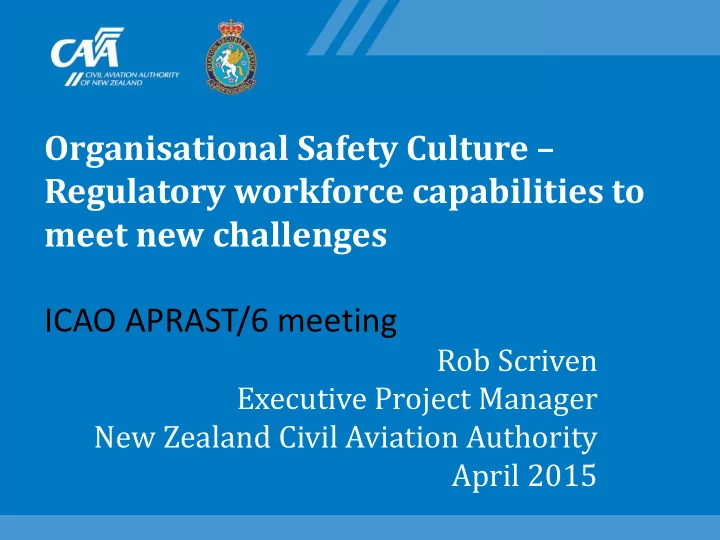

Organisational Safety Culture – Regulatory workforce capabilities to meet new challenges ICAO APRAST/6 meeting Rob Scriven Executive Project Manager New Zealand Civil Aviation Authority April 2015
Organisational Safety Culture Focus is on a sub-set – capabilities of its people Structure • Assumptions • Shared beliefs • Role of aviation regulator – NZ context • The Art of Regulation • Drivers for change • People - capability requirements • Regulator as a profession • Behaviours, behaviours, behaviours….. • Discussion
Organisational Safety Culture- Assumptions Organisational ‘success’ is delivered by shared beliefs and associated behaviours = culture Safety-culture needs to be understood by all Safety-culture needs to be actively managed That different levels of an organisational have different influences on the safety-culture Senior managers are the organisation’s safety - culture custodians and shapers Shared beliefs mould staff behaviours Culture can only be assessed through observing human behaviour.
Shared Beliefs Beliefs are emotions and assumptions that something is true. Beliefs are not inherent in people; they are learnt and arise from a common experience. When beliefs are shared a sense of community and group cohesion – or culture, occurs. Shared Beliefs = Culture
Assessing culture • Beliefs and hence culture can only be assessed and interpreted indirectly through observing human behaviours. • Describe the requisite behaviours clearly • Be clear on expectations with staff • Show staff the link between behaviours and the organisational shared belief (culture forms) • Actively assess those behaviours • Reward appropriate behaviours
The CAA’s shared belief Safety!
Role of the NZ CAA
Drivers for change SMS - performance (PBO) v compliance (CBO); increased complexity of regulatory decision making; increased tolerance of less failures from the public and central government rapidly changing and evolving technologies such as Performance Based Navigation (PBN) and Remotely Piloted Aerial Systems (RPAS).
The regulatory task – Sparrow (1) “Acknowledge the constant need to make choices. Make them rationally, analytically, democratically. Take responsibility for the choices you make. Organise yourselves to deliver important results. Choose specific goals of public value and focus on them. Devise methods that are economical with respect to the use of state authority, the resources of the regulatory community and the resources of the agency. And as you carefully pick and choose what to do and how to do it, reconcile your pursuit of effectiveness with the values of justice and enquiry.” The Regulatory Craft, Malcolm K. Sparrow, 2000
The regulatory task – Sparrow (2) Identify the big problems and fix them The Regulatory Craft, Malcolm K. Sparrow, 2000
Organisational attributes Move from • transactions to problem solving (focus on aviation risk) • activities to strategies • reactive to proactive • prescription to performance or outcome based
Organisational attributes The CAA must be an adaptive organisation with the intellect and capability to rise to the challenge of understanding the risks and implications and act accordingly – a developing and growing organisation that can THINK its way through the problems it is confronting as BAU – this is nothing to do with OD structure – CAA must not become a character of its structure
Regulator as a Profession • A sense of belonging • Share a core set of theoretical, practical and contextual knowledge • Recognised and respected • Guided by a common code of professional conduct and beliefs • Share a common language
The Aviation Regulator as a Professional Fusing aviation knowledge and skills with regulator craft, three layers of triangle • Good judgement and decision- making: what we want to achieve • The behaviours: the way we do things • Foundational skills and knowledge
15
Summary – NZCAA approach • Common beliefs can be learnt and lead to organisational culture • Capabilities of a regulator is fusing aviation and regulatory craft – treat as a profession • Culture measured by behaviours of its people • Clearer set expectations for behaviours • Constantly and consistently assess behaviours • Reward good behaviours
Discussion Questions?
Recommend
More recommend